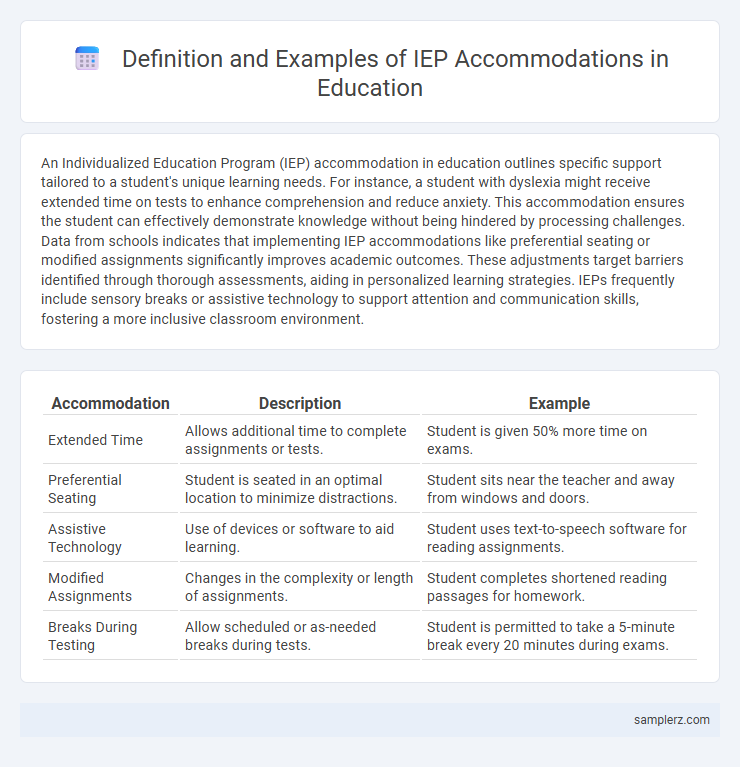An Individualized Education Program (IEP) accommodation in education outlines specific support tailored to a student's unique learning needs. For instance, a student with dyslexia might receive extended time on tests to enhance comprehension and reduce anxiety. This accommodation ensures the student can effectively demonstrate knowledge without being hindered by processing challenges. Data from schools indicates that implementing IEP accommodations like preferential seating or modified assignments significantly improves academic outcomes. These adjustments target barriers identified through thorough assessments, aiding in personalized learning strategies. IEPs frequently include sensory breaks or assistive technology to support attention and communication skills, fostering a more inclusive classroom environment.
Table of Comparison
| Accommodation | Description | Example |
|---|---|---|
| Extended Time | Allows additional time to complete assignments or tests. | Student is given 50% more time on exams. |
| Preferential Seating | Student is seated in an optimal location to minimize distractions. | Student sits near the teacher and away from windows and doors. |
| Assistive Technology | Use of devices or software to aid learning. | Student uses text-to-speech software for reading assignments. |
| Modified Assignments | Changes in the complexity or length of assignments. | Student completes shortened reading passages for homework. |
| Breaks During Testing | Allow scheduled or as-needed breaks during tests. | Student is permitted to take a 5-minute break every 20 minutes during exams. |
Understanding IEP Accommodations in Education
IEP accommodations in education include extended time on tests, preferential seating, and the use of assistive technology to support students with disabilities. These tailored adjustments address specific learning challenges by modifying the environment or presentation of material without altering the curriculum. Understanding IEP accommodations helps educators implement personalized strategies that enhance student success and ensure compliance with special education laws.
Common Classroom Accommodations in IEPs
Common classroom accommodations in Individualized Education Programs (IEPs) include preferential seating, extended time on tests and assignments, and the use of assistive technology such as speech-to-text software. Teachers may also provide written instructions alongside verbal directions and allow breaks during lessons to support students with attention or processing challenges. These accommodations are designed to create an equitable learning environment by addressing specific needs identified through comprehensive evaluations.
Sample IEP Accommodation Statements
Sample IEP accommodation statements include providing extended time for test completion to support students with processing challenges and offering preferential seating to minimize distractions for those with attention difficulties. Other accommodations often involve the use of assistive technology, such as speech-to-text software, to aid written expression and allowing breaks during lessons to help manage anxiety or fatigue. Tailoring these accommodations to individual student needs ensures accessibility and promotes effective learning within inclusive educational settings.
Accommodations for Testing in IEPs
Accommodations for testing in Individualized Education Programs (IEPs) often include extended time, a quiet testing environment, and alternative test formats such as oral presentations or large-print papers. These adjustments address specific learning disabilities or attention challenges to ensure fair assessment conditions. Providing such tailored supports helps students demonstrate their true capabilities without the constraints of their disabilities.
Technology Integration as IEP Accommodation
Technology integration as an IEP accommodation includes using assistive software like speech-to-text applications and audiobooks to support students with learning disabilities. Tools such as interactive whiteboards and tablets enable personalized learning experiences tailored to individual needs. These technology aids enhance accessibility and engagement, leading to improved educational outcomes for students with special education requirements.
IEP Accommodations for Reading Challenges
IEP accommodations for reading challenges often include extended time for reading assignments and tests, use of audiobooks or text-to-speech technology, and preferential seating to minimize distractions. These supports help students with dyslexia, processing delays, or other reading disabilities access the curriculum effectively. Tailored modifications in reading materials and individualized instruction strategies are also integral to IEP plans.
Flexible Scheduling as an IEP Accommodation
Flexible scheduling as an IEP accommodation allows students with disabilities to attend classes at times when they are most alert and able to focus, enhancing their learning experience. This accommodation may include extended time for tests, breaks between lessons, or alternate start times to reduce fatigue and anxiety. Implementing flexible scheduling supports academic achievement by addressing individual needs and promoting consistent engagement in the educational environment.
Modified Assignments in IEP Examples
Modified assignments in an Individualized Education Program (IEP) tailor academic tasks to meet a student's unique learning needs, often by simplifying content, reducing the number of questions, or adjusting the format for accessibility. These accommodations help students with disabilities access the curriculum more effectively while demonstrating their knowledge without being hindered by standard assignment requirements. Examples include shortened reading passages, simplified math problems, or alternative project formats that align with the student's goals and abilities.
IEP Accommodations for Physical Disabilities
IEP accommodations for physical disabilities often include the provision of assistive technology such as speech-to-text software and adaptive keyboards to support students with limited motor skills. Schools may also arrange for specialized seating, accessible classroom layouts, and modified physical education activities to ensure full participation. Physical therapists and aides are integrated into the learning environment to provide ongoing support that aligns with each student's individualized needs.
Collaboration Strategies in Implementing IEP Accommodations
Effective collaboration strategies in implementing IEP accommodations involve regular communication between special education teachers, general educators, and parents to ensure consistency and address student needs promptly. Utilizing shared digital platforms for real-time updates on accommodation use enhances coordination and accountability among all stakeholders. Incorporating scheduled interdisciplinary team meetings fosters a collaborative environment that supports tailored interventions and continuous progress monitoring for the student.

example of IEP in accommodation Infographic
 samplerz.com
samplerz.com